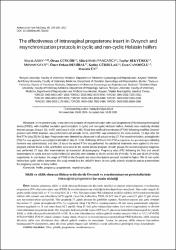| dc.contributor.author | Abay, Murat | |
| dc.contributor.author | Bekyürek, Tayfur | |
| dc.contributor.author | Pancarcı, Şükrü Metin | |
| dc.contributor.author | Kaya, Mehmet | |
| dc.contributor.author | Demiral, Ömer | |
| dc.contributor.author | Gürbulak, Kutlay | |
| dc.contributor.author | Canooğlu, Esra | |
| dc.contributor.author | Ün, Mustafa | |
| dc.date.accessioned | 2022-08-05T08:12:16Z | |
| dc.date.available | 2022-08-05T08:12:16Z | |
| dc.date.issued | 2021 | en_US |
| dc.identifier.issn | 1300-0861 - 1308-2817 | |
| dc.identifier.uri | https://doi.org/10.33988/auvfd.733140 | |
| dc.identifier.uri | https://hdl.handle.net/20.500.12462/12421 | |
| dc.description | Pancarcı, Şükrü Metin (Balikesir Author) | en_US |
| dc.description.abstract | In the present study, it was aimed to compare of resynchronization with used progesterone (P4) releasing intravaginal
device (PRID), with modified ovulation synchronization in cyclic and non-cyclic Holstein heifers. Animals were randomly divided
into two groups; Group I (GI, n=87) and Group II (GII, n=88). Fixed-time artificial insemination (FTAI) following modified Ovsynch
protocol with PRID insertion, was performed to all animals. In GI, used PRID was reinserted to the same animals, 15 days after the
first FTAI (day 25) for 12 days. Pregnancies were detected by ultrasound in all groups on day 37. For resynchronization, prostaglandin
(PG) F2α was applied to non-pregnant animals on day 37. In GI, following 48 hours from PGF2α injection, the gonadotropin-releasing
hormone was administrated, and after 18 hours the second FTAI was performed. No additional treatments were applied to the nonpregnant animals found in GII, and heifers were taken to the routine service program. In both groups, the second pregnancy diagnosis
was performed 27 days after inseminations by transrectal ultrasonography. Pregnancy rates (PR) following the first and overall
inseminations in cyclic and non-cyclic heifers (GI and GII) were detected as 66.4% and 52.3% (P>0.05); 76.3% and 59.1% (P>0.05),
respectively. In conclusion, the usage of PRID in the Ovsynch and resynchronization protocol resulted in higher PRs of non-cyclic
heifers than cyclic heifers. Moreover, this study reveals that the initial P4 levels of non-cyclic animals should be used as a determinant
for pregnancy success in dairy heifers. | en_US |
| dc.description.abstract | Sunulan çalışmada, siklik ve siklik olmayan Holştayn ırkı düvelerde modifiye ovulasyon senkronizasyonu ve kullanılmış
progesteron (P4) salan intravajinal araç (PRID) ile resenkronizasyonun etkinliğinin karşılaştırılması amaçlandı. Hayvanlar rastgele iki
gruba ayrıldı; Grup I (GI, n = 87) ve Grup II (G II, n = 88). Tüm hayvanlara PRID eklenerek modifiye edilmiş bir Ovsynch protokolünü
takiben sabit zamanlı suni tohumlama (SZT) yapıldı. Grup I’de, kullanılmış PRID, ilk SZT’dan 15 gün sonra (25. gün) 12 gün süreyle
aynı hayvanlara tekrar yerleştirildi. Tüm gruplarda 37. günde ultrason ile gebelikler saptandı. Resenkronizasyon için, gebe olmayan
hayvanlara 37. günde prostaglandin (PG) F2α uygulandı. Grup I’de PGF2α enjeksiyonundan 48 saat sonra gonadotropin salgılatıcı
hormon uygulandı ve 18 saat sonra ikinci SZT yapıldı. Grup II’ deki gebe olmayan hayvanlara ilave tedavi uygulanmadı ve düveler
rutin tohumlama programına alındı. Her iki grupta da ikinci gebelik teşhisi SZT’dan 27 gün sonra transrektal ultrasonografi ile yapıldı.
Siklik ve siklik olmayan düvelerdeki (GI ve GII) ilk ve tüm tohumlamaları takiben gebelik oranları sırasıyla %66,4 ve %52,3 (P>0,05);
%76,3 ve %59,1 (P>0,05) olarak saptandı. Sonuç olarak, Ovsynch ve resenkronizasyon protokolünde PRID kullanımı, siklik olmayan
düvelerin siklik olan düvelerden daha yüksek gebelik oranları ile sonuçlandı. Ayrıca, bu çalışma, siklik olmayan hayvanların
başlangıçtaki P4 düzeylerinin, sütçü düvelerde gebelik başarısı için belirleyici olarak kullanılması gerektiğini ortaya koymaktadır. | en_US |
| dc.language.iso | eng | en_US |
| dc.publisher | Ankara University Press | en_US |
| dc.relation.isversionof | 10.33988/auvfd.733140 | en_US |
| dc.rights | info:eu-repo/semantics/openAccess | en_US |
| dc.subject | Heifer | en_US |
| dc.subject | Pregnancy | en_US |
| dc.subject | Progesterone | en_US |
| dc.subject | Resynchronization | en_US |
| dc.subject | Düve | en_US |
| dc.subject | Gebelik | en_US |
| dc.subject | Progesteron | en_US |
| dc.subject | Resenkronizasyon | en_US |
| dc.title | The effectiveness of intravaginal progesterone insert in Ovsynch and resynchronization protocols in cyclic and non-cyclic Holstein heifers | en_US |
| dc.title.alternative | Siklik ve siklik olmayan Holştayn düvelerde Ovsynch ve resenkronizasyon protokollerinde intravajinal progesteron ilavesinin etkinliği | en_US |
| dc.type | article | en_US |
| dc.relation.journal | Ankara Universitesi Veteriner Fakultesi Dergisi | en_US |
| dc.contributor.department | Veteriner Fakültesi | en_US |
| dc.contributor.authorID | 0000-0002-7235-2502 | en_US |
| dc.identifier.volume | 68 | en_US |
| dc.identifier.issue | 2 | en_US |
| dc.identifier.startpage | 155 | en_US |
| dc.identifier.endpage | 160 | en_US |
| dc.relation.tubitak | "info:eu-repo/grantAgreement/TUBITAK/TOVAG-107O177" | |
| dc.relation.publicationcategory | Makale - Uluslararası Hakemli Dergi - Kurum Öğretim Elemanı | en_US |


















